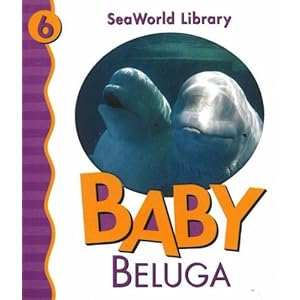 |
| Big Girl, in blue on right, watching her beloved beluga whales earlier this week. |
I can understand why she loves them so much. They are pretty cute. They are so clean-looking with their all-white skin. They look like they are constantly smiling. Of course, she had to spend her own cash in the gift shop on a stuffed version, which she named Juno after one of the whales at the aquarium. (I can't say I don't blame her for loving these creatures at her age -- I was just a year or two older when I visited the same aquarium with my school, and I remember buying a little beluga whale necklace in the gift shop and wearing it forever. It kind of looked like this.)
 |
| Whale feeding! |
A Mom's Guide to Beluga Whales!
The beluga whale is a small, toothed whale that is born grey but turns white as an adult. The word "beluga" means "white one" in Russian. Native to the Artic region, they grow to be about 15 feet long, and can weight around 3,300 lbs. They have a large "melon," which is their bulbous forehead, and lack a dorsal fin which makes swimming under ice sheets easier and also helps with retaining heat in their bodies. Their flippers are short, rounded and white. The whales have a very flexible neck, allowing it to turn its head, unlike other whales.
Belugas are very vocal -- so vocal that their nickname is "sea canary." Other nicknames are white whale, white porpoise and squid hound, the latter coming from a popular food in its diet.
Their tendency to be vocal, which can even be heard above water, is due to the whales' use of echolocation to locate prey, find breathing holes through ice and to navigate deep water. Basically, they use their voice to throw out a sound and see if it bounces off "something," like prey or ice. They also are very social, living in large groups, or pods, and use many sounds to communicate with other Beluga whales.
Belugas have 34 teeth, which are not used for eating -- they swallow food whole. The teeth are used for grabbing and tearing prey. They eat a varied diet of fish, squid, crustaceans, octopus and more.
Enchanted Learning has a great unit on Beluga whales with activity pages to print out for elementary school students. National Geographic's beluga page has audio capture of the whale. National Geographic Kids has a little fact card which kids can print out.
Other great links: SeaWorld's "Infobook" on belugas, a homeschool unit perfect for a whale lap book, a beluga coloring page (although you just might want to cut it the whale out and mount it on blue paper, since it's white!), an adorable mom-and-baby beluga page, or make a beluga mobile or puppet-on-a-stick by printing out this page on white cardstock and cutting the animals out. Older children may enjoy this lesson plan, "Beluga Whales In the Ice." Whale facts can also be found at this link.
There are seven aquariums in North America where one can see Beluga whales: Georgia Aquarium in Atlanta, Shedd Aquarium in Chicago, Mystic Aquarium in Connecticut, Vancouver Aquarium in Canada, SeaWorld San Diego, SeaWorld Orlando and SeaWorld San Antonio. Visit each site to find out more information on the species, on each aquarium's specific whales, or even Webcams to watch live video of the animals. Many of these aquariums have interaction programs, where for a fee you can interact personally with a beluga.
Both Atlanta and Shed aquariums have pregnant Beluga whales. Did you know that a Beluga mommy is pregnant for 14 months and the newborns weigh around 50 lbs?
You can adopt-a-beluga via the World Wildlife Fund. It would make a great gift for a beluga fan!
The twins did not come with Big Girl and I to the aquarium, but I didn't leave them out of the beluga fun. We surprised them with this little book from the gift shop:
Although it's a board book, it's a great book for older kids too, with a lot of information on belugas and real photos. If you search "beluga" under the children's books section on Amazon.com, you'll find many books on beluga whales for children. Another one for the tiny toddler set is "Baby Beluga," based on a song by Raffi. Little whale fans might also feel at home in a variation of the children's room below, which has a whale mural and framed beluga photos. (Framed photos that you've taken yourself are a great and inexpensive way to decorate a room and become not only art of a favorite animal, but memories of a fun day!) I was thinking that this room would be cute not only for a baby, but also for a toddler transition or big kid bed room, and perfect as a gender-neutral option for boy/girl twins, which I am always researching! It's very calming and sweet:
If you are looking for beluga "stuff," I did a quicky Etsy search and here is the link. There are some really cute things, including adorable little necklaces and a sweet crochet pattern for a stuffed toy.
Finally, I could not write about beluga whales without sharing this: My daughter has been a big fan of the video below since we first saw it last year. In fact, this was taken at our local aquarium, and my daughter named her stuffed beluga "Juno" after this very whale, who is the exactly the same age as she is, right down to the month. The video shows how very sweet these whales are:
I hope you enjoyed our beluga whale research as much as we did!
When you take a day trip, help your kids learn a little "extra"
to feed their natural curiousity!




No comments:
Post a Comment